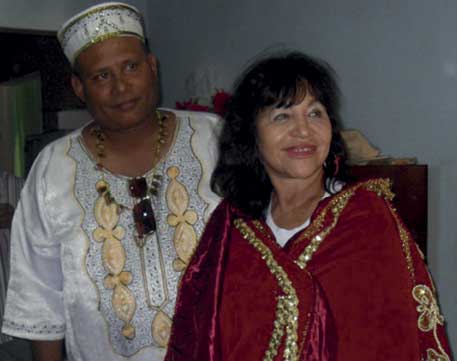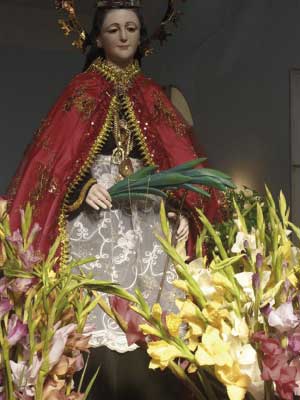 History and religion come together each December 4 when the people of Guines, in the province of Mayabeque, venerate the first image of Santa Barbara who came to Cuba 150 years ago. On this occasion Zaida del Rio, the renowned figure of the Cuban Contemporary Art graced the venue of the traditional festivities.
History and religion come together each December 4 when the people of Guines, in the province of Mayabeque, venerate the first image of Santa Barbara who came to Cuba 150 years ago. On this occasion Zaida del Rio, the renowned figure of the Cuban Contemporary Art graced the venue of the traditional festivities.
Walking the streets of Leguina, first settlement of the territory, and also visiting the chapel and the birthplace museum of Federico Aristides Soto, famed percussionist Tata Guines, were among the biggest thrills for the artist.
Again, the almanac marked the December 4 and to revere Chango was not something new to Zaida this year. "I knew about the popular tradition thanks to the documentary Copa y espada (Cup and sword), by the filmmaker Lourdes de los Santos, in which some of my works on that deity appear: the religion, tattoos and other issues," she confesses.
The plastic artist has worked Afro-Cuban culture. "A huge, free and profound world that allows me to go into the Yoruba religion, but I also enjoy finding the new and different, which is the source of my work. I also like the sea, the land and to fly inspired by the philosophy ", Del Rio says.
Excited by the welcome of the people and the energy of the devotees to Chango, Zaida toured the community project Patio de Tata Guines and gave prestige to the Art, Ethnology and Cultural scientific event.
She also visited historical sites such as El Coleo, bullfighting sculpture subject by the Spanish sculptor Mariano Benlliure. There she met the naturalist style reflected in her popular religious themes and imagery works.
Zaida del Rio, courageous as Chango, is a woman in the artistic vanguard the breaks conceptual schemes by weaving skills, textures and colors, to form the symbolic representation of Cuban traditions in more than twenty paintings.
 This December 4, 2014 she became a local and participated in cultural activities attended by people of all ages, sexes and creeds, to show that there is religious freedom in Cuba. It is precisely this diversity that lets you know the syncretism that exists on the island.
This December 4, 2014 she became a local and participated in cultural activities attended by people of all ages, sexes and creeds, to show that there is religious freedom in Cuba. It is precisely this diversity that lets you know the syncretism that exists on the island.
During the celebration, Zaida del Rio could see over a hundred cloaks the devotees have sent Santa Barbara, which is a collection of priceless value.
The prestigious painter farewell to the people and thanked the persons who put all their efforts to make this celebration dating back to 1860, when former African slaves and descendants of the lucumí council began the festivities.
Genesis of a tradition
With the conquest and Spanish colonization in Cuba, it began an intense transcultural process. The traditions and customs of Cubans are nourished by the Spanish and African influences, as well as other competing cultures, to make up our folklore.
Mastered Barbaro Sulet Aguiar, historian of Leguina neighborhood says the sculptural image of Santa Barbara came in 1864, it measures 1.36 meters in height and was purchased at a cost of 23 ounces gold in Barcelona, Spain.
The present chapel was built in 1955 as a result of a popular collection; nearly forty thousand people came to its opening, according to data indicate the time. Since then, festivities and Santa Barbara cults are an expression of identity of the town of San Julián de los Guines, and a source of gathering for families and friends.
"This phenomenon comes from two foundational sources of Cuban culture: Hispanic and African roots, which are specified in the religious sphere with Catholic Santa Barbara and Orisha Chango" the historian says.
Music, dance, theater and other events attended this tribute to people, besides the culinary arts based in animals like sheep, quail, cock, bull, turkey and tortoise, traditional meal elaborated for the celebration at home by neighbors.
In the afternoon of December 4 a procession takes place, in which thousands of people dressed in red costumes participate, while the night is enlivened with touches of bembé, presentations of musical groups and other cultural events where the rumba in Leguina neighborhood takes over the place.
Throughout these years, the chapel was visited by important personalities of Cuban culture as Abel Prieto, advisor of President Raul Castro; Lázaro Ross, known singer of the National Folklore Band; Tata Guines, famed percussionist; Eusebio Leal, Historian of Havana, and Celina Gonzalez, the queen of country music.
In 2002 the site received the Memoria Viva National Award, awarded by the Center for Research and Development of Cuban Culture Juan Marinello.
Every year, in December 3 and 4 the Chapel of Santa Barbara welcomes thousands of devotees who come to worship, asking for health, good luck and participate in the festivities. Undoubtedly, this is the most popular and rooted tradition in Güines, and also the oldest and syncretic religious revelation.










